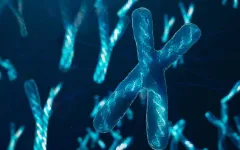(Press-News.org) DURHAM, N.C. -- Living things from bacteria to plants to humans must constantly adjust the chemical soup of proteins -- the workhorse molecules of life -- inside their cells to adapt to stress or changing conditions, such as when nutrients are scarce, or when a pathogen attacks.
Now, researchers have identified a previously unknown molecular mechanism that helps explain how they do it.
Studying a spindly plant called Arabidopsis thaliana, a Duke University-led team discovered short snippets of folded RNA that, under normal conditions, keep levels of defense proteins low to avoid harming the plants themselves. But when the plants detect a pathogen, these folded RNA structures are unzipped, enabling plant cells to make defense proteins to fight infection.
This discovery doesn’t just apply to plants, the authors noted in their Sept. 6 publication in the journal Nature. They also found that these RNA structures have similar effects on protein production in human cells, too.
“It’s another tool in our toolkit” to control protein production, said Duke biology professor Xinnian Dong, senior author of the study.
In the soupy interior of every cell in the body, millions of protein molecules carry out the tasks of life: They are the cellular equivalent of bricks and beams, providing structure and support. They’re also the cell’s chemical messengers, sending and receiving signals. And they’re the defenders, deployed in response to foreign invaders.
To build a protein, sections of the DNA blueprint packed inside the cell’s nucleus are transcribed into messenger molecules called mRNA, which are instructions for making proteins. These instructions are carried out to the rest of the cell, where decoding devices called ribosomes translate the mRNA’s message to assemble a chain of amino acids, the building blocks of a protein.
Normally, ribosomes scan along the mRNA molecule until they find a special three-letter sequence that says, "start here to make a protein."
But in the new study, Dong and Yezi Xiang, a Ph.D. student in Dong’s Lab, found that, when an Arabidopsis seedling detects a potential pathogen, the plant’s ribosomes bypass the usual ’start’ signal for protein synthesis and begin translating the mRNA further downstream, building a completely different chain of amino acids -- and thus a different protein -- required for fighting infection.
Dong and her team wanted to know: how do cells make the switch from one start site to another?
To better understand this rapid cellular decision-making that takes place when a plant detects an invader, the researchers turned to a technique, called SHAPE-MaP, that allows them to detect changes in mRNA folding within living cells.
Near the usual ‘green light’ that sets protein synthesis in motion, the researchers discovered short stretches of mRNA that fold back upon themselves to form double-stranded “hairpin" structures.
Under normal conditions, these hairpins act as brakes, preventing ribosomes from making defense proteins whose instructions lie further downstream.
But when Arabidopsis seedlings sense they’re under attack, special enzymes called RNA helicases are produced that unzip the hairpins so the ribosomes can pass through and continue scanning along the mRNA molecule.
“With these stop signs removed, the ribosomes don’t stop there, but go further down to translate defense proteins,” Dong said.
Though the team did the bulk of their experiments in Arabidopsis plants, similar RNA helicases and hairpin structures have been found in other organisms, from yeast to humans, suggesting that this mechanism for reprogramming protein synthesis may be widespread.
In follow-up experiments, the researchers used machine learning to come up with a design for a lab-made mRNA hairpin and added it to human genes. The synthetic hairpins worked to alter protein production in human cells, too.
The team has filed for a provisional patent on the discovery.
Dong says the findings could lead to new ways to engineer crops that are “not only resistant to pathogens, but also to environmental stresses like heat, cold, and drought.”
In the future, Dong said, it might also be possible to design mRNA hairpins for genome editing to help fight infections or treat diseases in people.
“The goal is to help cells produce the right amount of protein at the right time and the right place,” Dong said. “This is a step towards that goal.”
This work was supported by grants from the U.S. National Science Foundation (IOS-1645589 and IOS-2041378), the Howard Hughes Medical Institute, the State Key Research Development Program of China (2019YFA0110002), the Natural Science Foundation of China (32125007 and 91940306), and the U.S. National Institutes of Health (R35-GM122532).
CITATION: "Pervasive Downstream RNA Hairpins Dynamically Dictate Start-Codon Selection," Yezi Xiang, Wenze Huang, Lianmei Tan, Tianyuan Chen, Yang He, Patrick S. Irving, Kevin M. Weeks, Qiangfeng Cliff Zhang & Xinnian Dong. Nature, Sept. 6, 2023. DOI: 10.1038/s41586-023-06500-y
END
Unzipping mRNA rallies plant cells to fight infection
New tool controls protein production in living cells, with potential applications from agriculture to medicine.
2023-09-20
ELSE PRESS RELEASES FROM THIS DATE:
New research findings: Understanding the sex life of coral gives hope of clawing it back from the path to extinction
2023-09-20
For the first time, scientists have mapped the reproductive strategies and life cycle of an endangered coral species, offering hope it can be clawed back from the path to extinction.
The purple cauliflower soft coral, Dendronephthya australis, is endemic to south-eastern Australia, with the largest populations historically found in the Port Stephens estuary in New South Wales. It is one of the 100 priority species on the Federal Government’s Threatened Species Strategy.
Not only is the future ...
New model for in vitro production of human brown fat cells lays groundwork for obesity, diabetes cell therapy
2023-09-20
Brown adipocytes are specialized cells that can use energy to produce heat. This property makes them attractive tools for the treatment of diseases like obesity and type 2 diabetes. Until recently, this therapeutic potential was constrained by limited understanding of how brown adipocyte tissue (BAT) develops from precursors.
A team led by investigators at Brigham and Women’s Hospital, a founding member of the Mass General Brigham healthcare system, identified a set of cellular signaling cues that lead up to brown ...
College athletes experience worse post-injury outcomes for concussions suffered outside of sports
2023-09-20
Philadelphia, September 20, 2023 – Researchers from Children’s Hospital of Philadelphia (CHOP) found that college athletes had worse post-injury outcomes related to concussions they experienced outside of sports than those they experienced while playing sports. Additionally, female athletes who sustained their injury outside of sports had more severe symptoms and more days in sports lost to injury relative to male athletes. These findings suggest the need for improved concussion recognition, reporting, and monitoring outside of sports.
The study was recently published online by the Journal of Athletic Training.
Concussions have the potential to ...
CHOP researchers develop novel method using MRI to study diseases modeled in zebrafish
2023-09-20
Philadelphia, September 20, 2023 – Zebrafish have revolutionized research into a wide variety of rare and complex genetic diseases. In early development stages, their transparent bodies allow researchers to more easily study tissues and organs. However, studying organ-level defects in adult zebrafish presents a variety of challenges that prevent researchers from studying them at a microscopic level.
In a new study, researchers from Children’s Hospital of Philadelphia (CHOP) have developed a noninvasive method for conducting magnetic resonance imaging (MRI) in adult zebrafish. ...
15 top journalists earn aging-focused reporting fellowships
2023-09-20
The Gerontological Society of America (GSA) and the Journalists Network on Generations are welcoming 15 distinguished reporters for the next cohort of the Journalists in Aging Fellows Program, now in its 14th year.
They represent a wide range of general audience, ethnic, and community media outlets, including local and national publications. This year’s group brings the program’s total number of participating reporters to 232. The new fellows were chosen — by a panel of gerontological and editorial professionals — based on their proposals for ...
A brighter brain future for all: AAN sets new vision for brain health by 2050
2023-09-20
MINNEAPOLIS – Do you want to improve your brain health? Neurologists, the experts in brain health, have a plan. The American Academy of Neurology (AAN), the world’s largest association of neurologists and neuroscience professionals with over 40,000 members, is sharing its vision to improve the nation’s brain health by 2050. The new vision is part of a new AAN position statement on brain health, published online September 20, 2023, in Neurology®, the medical journal of the American Academy of Neurology.
The AAN’s vision for national brain health by 2050 includes:
Brain health research that leads to scientific breakthroughs
Preventive neurology as a thriving ...
St. Jude refines definition and hones treatment of hyperdiploid leukemia
2023-09-20
(Memphis, Tenn.— Sept. 20, 2023) Hyperdiploidy is a genetic condition observed in cancer cells, where the cells contain more chromosomes than usual. The condition is particularly prevalent in childhood B-cell acute lymphoblastic leukemia (B-ALL), the most common form of pediatric cancer. To bring clarity to the field, researchers at St. Jude Children’s Research Hospital worked to better define this type of ALL in the context of modern therapy to more accurately predict patient outcomes and guide treatment decisions. The findings were published today in the Journal of Clinical ...
USC develops new preclinical system to better turn lab discoveries into effective treatments
2023-09-20
It is an all-too-common fact that potential drugs can look extremely promising in preclinical laboratory testing but fail when it comes to effectively treating humans. To better translate promising lab findings into effective new treatments, a team of researchers from the Keck School of Medicine of USC, supported by the National Institutes of Health, has developed, and tested, an innovative new system for conducting preclinical research on six potential new stroke treatments, identifying the strongest candidate for further study.
“We now have a feasible preclinical research system ...
Health organizations host Forum on Innovation and the Health Care Workforce
2023-09-20
The American College of Cardiology (ACC), NCD Alliance and World Heart Federation (WHF), with support from Viatris, brought together leaders in global health and technology for a “Enhancing the Health Workforce Through Innovation,” forum yesterday in New York. The event was held in advance of the 78th session of the U.N. General Assembly discussion on the need for universal health coverage to improve global access to care and reduce the out-of-pocket burden of rising health care costs.
“ACC has been committed to improving health care for all ...
DPP4 inhibitors for target therapy resistance in renal cell carcinoma
2023-09-20
“[...] we demonstrated that DPP4 inhibition increased sunitinib efficacy in DPP4-high RCC spheroids and DPP4 was upregulated in sunitinib-resistant RCC cells.”
BUFFALO, NY- September 20, 2023 – A new editorial paper was published in Oncotarget's Volume 14 on September 15, 2023, entitled, “Potential repurposing of DPP4 inhibitors for target therapy resistance in renal cell carcinoma.”
In their new editorial, researchers Kuniko Horie and Satoshi Inoue from Saitama Medical University and Tokyo Metropolitan Institute for Geriatrics and Gerontology discuss renal cell carcinoma (RCC) — a major ...
LAST 30 PRESS RELEASES:
Sleeping in on weekends may help boost teens’ mental health
Study: Teens use cellphones for an hour a day at school
After more than two years of war, Palestinian children are hungry, denied education and “like the living dead”
The untold story of life with Prader-Willi syndrome - according to the siblings who live it
How the parasite that ‘gave up sex’ found more hosts – and why its victory won’t last
When is it time to jump? The boiling frog problem of AI use in physics education
Twitter data reveals partisan divide in understanding why pollen season's getting worse
AI is quick but risky for updating old software
Revolutionizing biosecurity: new multi-omics framework to transform invasive species management
From ancient herb to modern medicine: new review unveils the multi-targeted healing potential of Borago officinalis
Building a global scientific community: Biological Diversity Journal announces dual recruitment of Editorial Board and Youth Editorial Board members
Microbes that break down antibiotics help protect ecosystems under drug pollution
Smart biochar that remembers pollutants offers a new way to clean water and recycle biomass
Rice genes matter more than domestication in shaping plant microbiomes
Ticking time bomb: Some farmers report as many as 70 tick encounters over a 6-month period
Turning garden and crop waste into plastics
Scientists discover ‘platypus galaxies’ in the early universe
Seeing thyroid cancer in a new light: when AI meets label-free imaging in the operating room
Neutrophil-to-lymphocyte ratio may aid risk stratification in depressive disorder
2026 Seismological Society of America Annual Meeting
AI-powered ECG analysis offers promising path for early detection of chronic obstructive pulmonary disease, says Mount Sinai researchers
GIMM uncovers flaws in lab-grown heart cells and paves the way for improved treatments
Cracking the evolutionary code of sleep
Medications could help the aging brain cope with surgery, memory impairment
Back pain linked to worse sleep years later in men over 65, according to study
CDC urges ‘shared decision-making’ on some childhood vaccines; many unclear about what that means
New research finds that an ‘equal treatment’ approach to economic opportunity advertising can backfire
Researchers create shape-shifting, self-navigating microparticles
Science army mobilizes to map US soil microbiome
Researchers develop new tools to turn grain crops into biosensors
[Press-News.org] Unzipping mRNA rallies plant cells to fight infectionNew tool controls protein production in living cells, with potential applications from agriculture to medicine.


